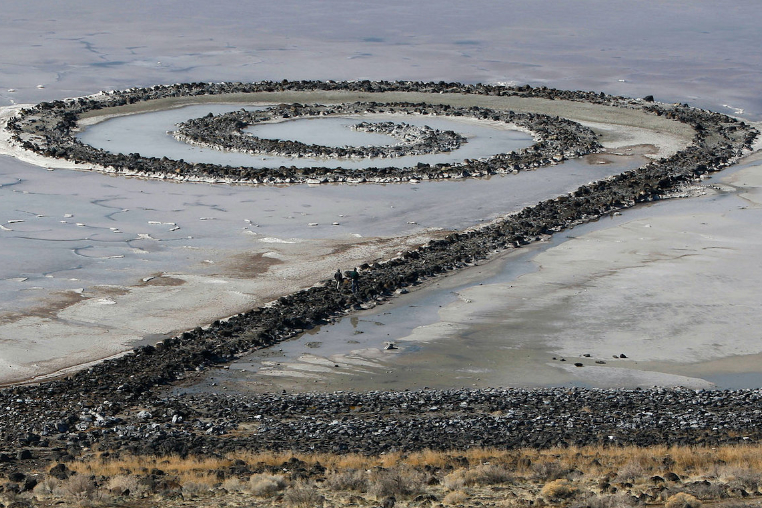What is environmental art
Environmental artists, a sustainable trend
Art and the environment appeal to reason and feelings. What happens when we mix them? The answer is environmental art, a movement adopted by artists of different disciplines, who are inspired by nature or use it as a raw material, transmitting its beauty and encouraging us to take care of it.

The natural wonders of the planet have inspired us to express ourselves in more than words for thousands of years. From Palaeolithic cave paintings to high impact digital photographs of the animal kingdom. However, the environmental crisis we now experiencing has driven a new artistic movement that goes beyond capturing and depicting nature as in the past, to transforming nature into the work itself.
Art and nature
The first thing that comes to mind when you think of nature in art is landscapes. This genre of painting has been popular in Asia since ancient times but was disparaged in Europe until it became fashionable in the Dutch baroque period and was then exported to other countries. The world's most renowned landscape painters include the Flemish master Jacob van Ruisdael, John Constable from England, American Thomas Cole, Dutchman Vincent Van Gogh and Monet and Cézanne from France, among many others.
Nature is also a recurring theme in other visual arts. It has inspired everything from the gardens of Versailles (France) by André Le Nôtre to sculptures like Peine del Viento by Eduardo Chillida in San Sebastián (Spain) and the photographs of Yosemite National Park in the United States by Californian Ansel Adams. Japanese architecture blends into its surroundings by using plant materials like paper, bamboo and wood.

'Green Wheat Fields, Auvers', by Vincent Van Gogh (1890).

'The Poppy Field near Argenteuil', by Claude Monet, 1875.

'Mont Sainte-Victoire', by Paul Cezanne, (1902-1906).
Characteristics and aims of environmental art
Environmental art encompasses these traditional genres and modern art, addressing ethics and conservationist activism. This new approach to art emerged at the end of the sixties and, unlike the classics, it does more than depict a landscape or include the environment in its creations. The environment becomes the work of art, to raise awareness of the harm we are causing to the environment and call us to action.
Our polluted air and oceans, global warming, deforestation and the consequences of mass consumption for the environment are among the subjects dealt with by contemporary environmental art through photography, painting, drama, dance and sculpture, among other disciplines. Ecoart uses natural, sustainable materials like earth, stones, leaves and branches.
The main aims of environmental art are to:

Recycled art
Upcycled art, when waste becomes art.

Sustainable museums
How can our heritage be conserved while respecting the environment?

Monuments of the world
The best natural and historical monuments in the world.

Plastic instead of water
A work of arte symbolizing the ocean emergency.
From 'land art' to 'arte povera'
Environmental art encompasses other, similar movements, such as ecological art, arte povera and land art. The last of these changes the landscape by installing large-scale works of art, such as gigantic spirals, ditches and ramps created using the land itself or natural materials, to inspire emotions in those who view them. The first examples of land art appeared in the United States at the end of the sixties and, generally, the works mutated and ended up disappearing due to erosion.
Keys about environmental art





Source: UNALMED.
 SEE INFOGRAPHIC: Keys about environmental art [PDF] External link, opens in new window.
SEE INFOGRAPHIC: Keys about environmental art [PDF] External link, opens in new window.
Arte povera (poor art) emerged in Italy during the same period as land art and is characterised by the use of 'poor' raw materials that are easy to obtain, such as earth, rocks, plants, etc. The purpose is to provoke thought by working with the materials and observing its specific qualities. These are works that reject the commercial side of art, that require public intervention and are transformed over time as the materials used break down.
Great environmental artists

Spiral Jetty, by Robert Smithson, in Utah, United States.

A sculpture from the 'Rhythms of Life' series by Andrew Rogers.

Work by Andy Goldsworthy.
The following is a list of some of the best-known artists from this artistic movement:
-
Herman de Vries: this Dutch sculptor (1931) based in Germany is one of the precursors of contemporary environmental art. His works feature natural items from around the world to highlight their biodiversity.
-
Andy Goldsworthy: British sculptor and photographer (1956) who has been making amazing creations for two decades. He creates temporary works in forests and riverbeds with no more than his own hands.
-
Joseph Beuys: this multidisciplinary German artist (1921-1986) created 7000 Oaks, one of the 20th century's most significant works of environmental art. Beuys and his team used 7,000 oaks to replant several contaminated areas.
-
Robert Smithson: an American artist (1938-1973) who created massive, temporary works of art, one of which was Spiral Jetty in the Great Salt Lake in Utah. He died in a plane crash while searching for the location of his next work.
-
Andrew Rogers: works use natural materials and are global in nature. His Rhythms of Life sculpture project started in 1998 and consists of 51 monumental stone sculptures in 16 countries.
-
Agnes Denes: Hungarian artist (1931) who began her career as a poet and became a pioneer of environmental art in the 1970s. From her first work in Sullivan Country in the US in 1968 to the Living Pyramid of 2022 in Istanbul, she has shown how pollution destroys the environment.







